Wat Mahathat In Thailand: Immerse Yourself In Ancient Splendour
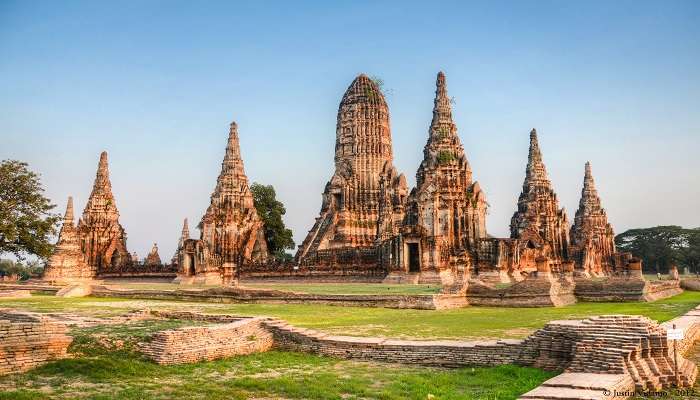
Thailand, also known as The Land of Smiles, is very rich in culture and history which is indicated by the magnificent temples. Among them stands Wat Mahathat in Thailand or the Temple of the Great Relic. It is scattered across various locations, each with its own compelling story to tell. The temple in Sukhothai is known for its graceful lotus-bud chedi, the one in Bangkok is known for its iconic towering prang and the Wat Mahathat Ayutthaya is appreciated for its picturesque Buddha head in the roots of a Bodhi tree. All these temples are a must-visit for anyone seeking spiritual escape and having a desire to know about the rich Thai cultural history.
Wat Mahathat In Thailand: Revealing Grandeur

Wat Mahathat Ayutthaya stands as a testament to the glorious Ayutthaya Kingdom. It was once a central temple complex where it housed Buddha relics while serving as the centre for Buddhism religion. The construction process involved King Borommarachathirat I around 1374 when he ordered Wat Mahathat Ayutthaya should be built so that it could witness the rise and fall phases associated with the Ayutthaya Kingdom.
Central prang (spire) that towers above all buildings of this temple complex, the grand principal viharn (assembly hall), and numerous chedis (stupas), were all part of this temple complex. Inevitably, during the 18th century, Burmese invasions caused significant damage. Thus today ruins serve as evidence of past splendour seen in Wat Mahathat Ayutthaya. Perhaps one of the most iconic things about Wat Mahathat Ayutthaya is seeing a headless Buddha image entwined partially by Bodhi tree roots symbolising the enduring power and tranquillity offered by Buddhism. Make sure you don’t leave without exploring the remaining prang base, ordination hall ruins along with many chedis that are scattered all over the complex. Each of these structures whispers stories of the past, giving us a chance to know where we are today.
Must Read: Backpacking In Thailand
Wat Mahathat In Thailand Ayutthaya: Fascinating Details
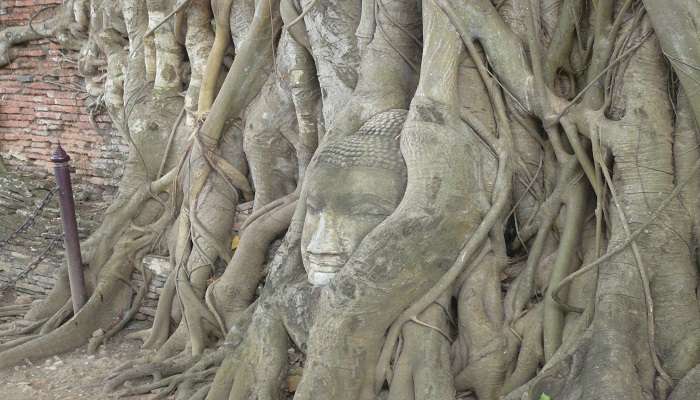
Apart from the famous Buddha’s head entwined in the tree roots, there is more to explore at Wat Mahathat Ayutthaya including historical significance and various architectural wonders.
The Central Prang: The central prang, which was very tall, used to form the centre of attraction in this temple complex. Its square base gradually changed to resemble a lotus bud meant for spiritual enhancement. Religious historians say that some sacred relics, like Buddha’s tooth, existed within it.
The Principal Viharn (Assembly Hall): Despite its disrepair, parts of the main vihara indicate the architectural grandeur of Wat Mahathat Ayutthaya. It might have had a multi-tiered roof, detailed carvings, and murals containing scenes drawn from Buddhist mythology.
Elephant Kraal: Another interesting structure near Wat Mahathat Ayutthaya is the elephant kraal- an enclosure where wild elephants are caught and tamed.
Wat Mahathat In Thailand Yuwaratrangsarit: A Royal Legacy in Bangkok
Even if the most famous Wat Mahathat is located in Ayutthaya, people may not know that Bangkok houses another significant temple named under this name – Wat Mahathat Yuwaratrangsarit.
Royal Sanctuary
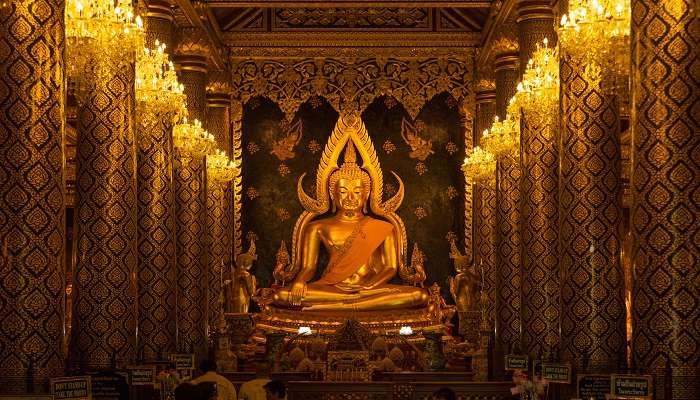
It is situated strategically between the Grand Palace and Front Palace, making Wat Mahathat Bangkok a popular site for royal funerals and other ceremonies. Over the years, many Thai kings have renovated the temple, which is currently one of the ten top-ranked royal temples in Bangkok, Wat Mahathat Yuwaratrangsarit.
Suggested Read: Thailand In April
Architectural Marvels
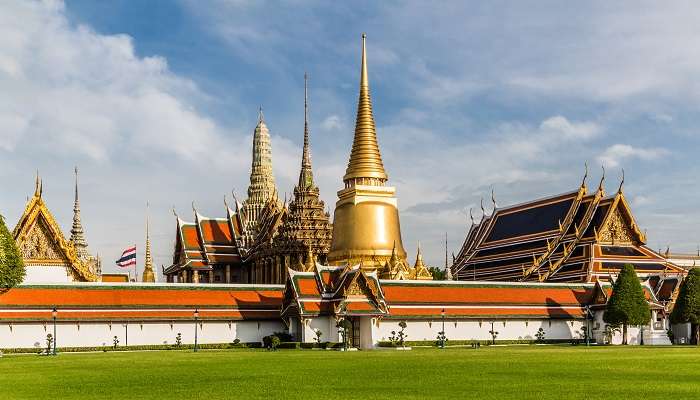
Wat Mahathat Yuwaratrangsarit is a remarkable example of Thai and European architecture. The main assembly hall, called “viharn”, has a peculiar red front with intricately worked plaster on all sides and several floors in its roof. Once inside, visitors can admire beautiful murals depicting scenes from the Jataka tales (stories of Buddha’s previous lives). Another interesting feature is the prang, which resembles a Khmer-style stele covered in fine carvings. The temple complex also includes buildings such as the ordination hall (“bot”), the library (“ho trai”) and various chedis (stupas) that contain royal ashes.
The Viharn (Assembly Hall)
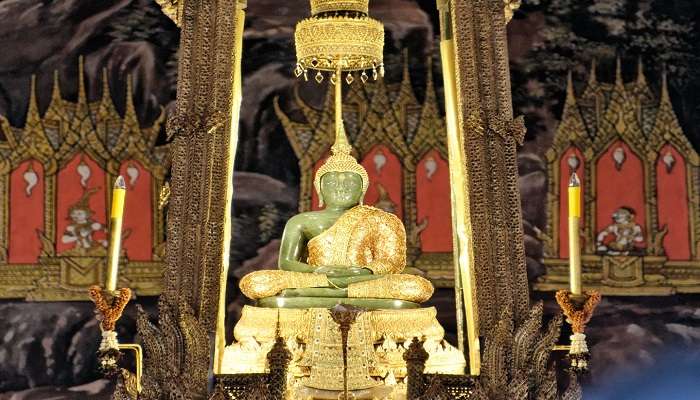
The principal vihara is the most captivating structure in Wat Mahathat Yuwaratrangsarit. It has a red façade with intricate stucco work involving floral and geometric patterns. A multi-tiered roof typical for Thai temples adds to its grandeur. Inside, there are large Buddha statues and beautifully painted murals of Jataka tales or Buddha’s previous lives, which teach us moral values and ways to reach enlightenment.
Suggested Read: Monasteries In Thailand
The Ho Trai (Library)
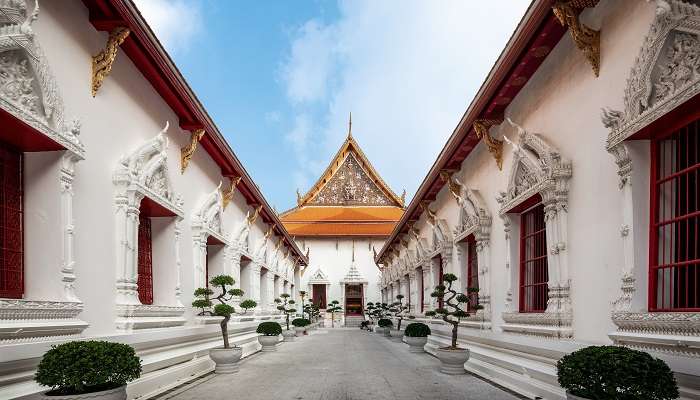
As one of the most important structures within the temple precincts, Wat Mahathat Yuwaratrangsarit houses the Ho Trai or the library. Traditionally, they preserved palm-leaf manuscripts containing Buddhist scriptures and other religious texts. It is evidence of this temple’s role in protecting Buddhist wisdom as an institution of knowledge for Buddhists. The ho trai’s architecture typically follows square or rectangular shapes with uniquely designed multiple-layered roofs.
Wat Mahathat In Thailand Sukhothai: Cradle of Thai Civilization
Proceed northwards to Sukhothai, the cradle of Thailand’s civilisation; there is another significant Wat Mahathat there.
A Legacy Of Sukhothai Kingdom
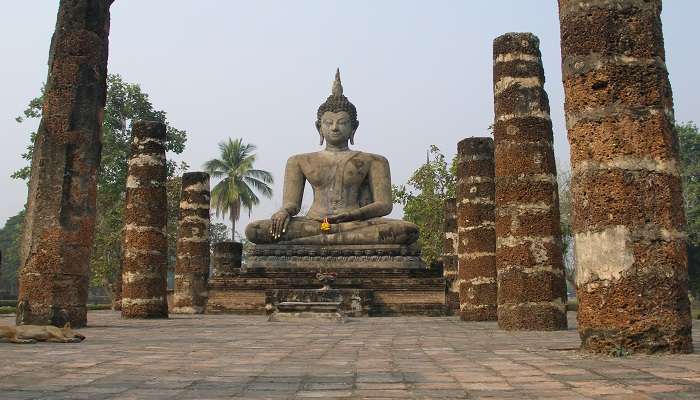
The golden age (13th-15th centuries) kingdom called Sukhothai built Wat Mahathat Sukhothai, which stands as a living testimony to the beauty of architectural design and artistry that marked this era. There’s a central prang surrounded by many chedis (stupas) in different sizes around the temple compound. These structures were made to store relics or to remember important people. The four corners have stupas shaped like lotus buds on top, and elephants are at their base, forming part of its dominant feature. The surrounding chedis show different architectural styles reflecting the evolution of Sukhothai art. Some chedis are bell-shaped while others have designs with more squared bases containing intricate carvings.
Suggested Read: Beaches In Belize
UNESCO World Heritage Site
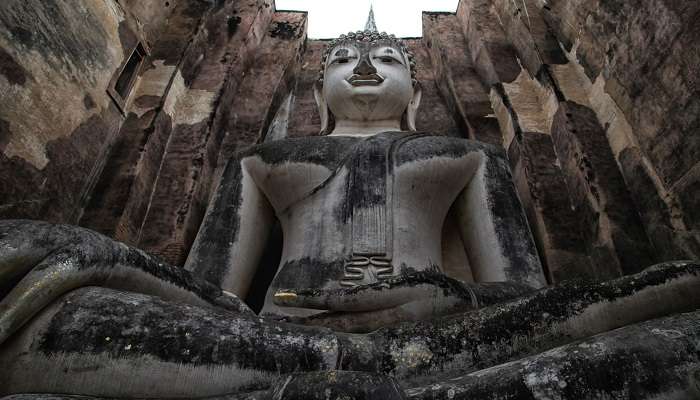
The world-famous Wat Mahathat Sukhothai is full of historical and cultural values. It is in the Sukhothai Historical Park, a UNESCO World Heritage Site. The park, some 70 km in size, consists of parts of the royal city of the ancient Kingdom of Sukhothai – palaces, temples and wat phra (monasteries). Discovering Wat Mahathat Sukhothai can give you hints about its art heritage or religious beliefs during the era.
Further Read: Places To Visit In South Thailand
Wat Mahathat in Thailand serves as a place of worship and a symbol of the nation’s remarkable culture, art and history. The serene ambience and awe-inspiring beauty of these temples will completely rekindle your spiritual spirit and make you feel at peace. So, book a trip to Thailand and be prepared to be enchanted by the captivating magnificence of these famous temples.
For our editorial codes of conduct and copyright disclaimer, please click here.
Frequently Asked Questions About Wat Mahathat In Thailand
What is special about Wat Mahathat temples?
They were central to Buddhism historically as they housed sacred relics. They also served as royal monasteries and venues for important ceremonies.
Can we take pictures at Wat Mahathat?
Photography is acceptable in Wat Mahathat temples but avoid disturbing worshippers with flashlights inside sacred buildings.
Is there an entrance fee to visit Wat Mahathat?
Yes, adults have to pay 50 baht each, whereas children have free admission.
What are the opening hours of Wat Mahathat Sukhothai Thailand?
Wat Mahathat Sukhothai Thailand is open from 8 am to 5 pm everyday except on public holidays.
What should I wear while visiting the Wat Mahathat?
Since these are religious sites, it’s important to dress modestly. You can opt for long pants or skirts that cover your knees, and shirts with sleeves covering your shoulders; Avoid anything too revealing or clothes bearing offensive slogans.
People Also Read:
Chiang Mai Trekking Paragliding In Thailand Thailand Island Resorts
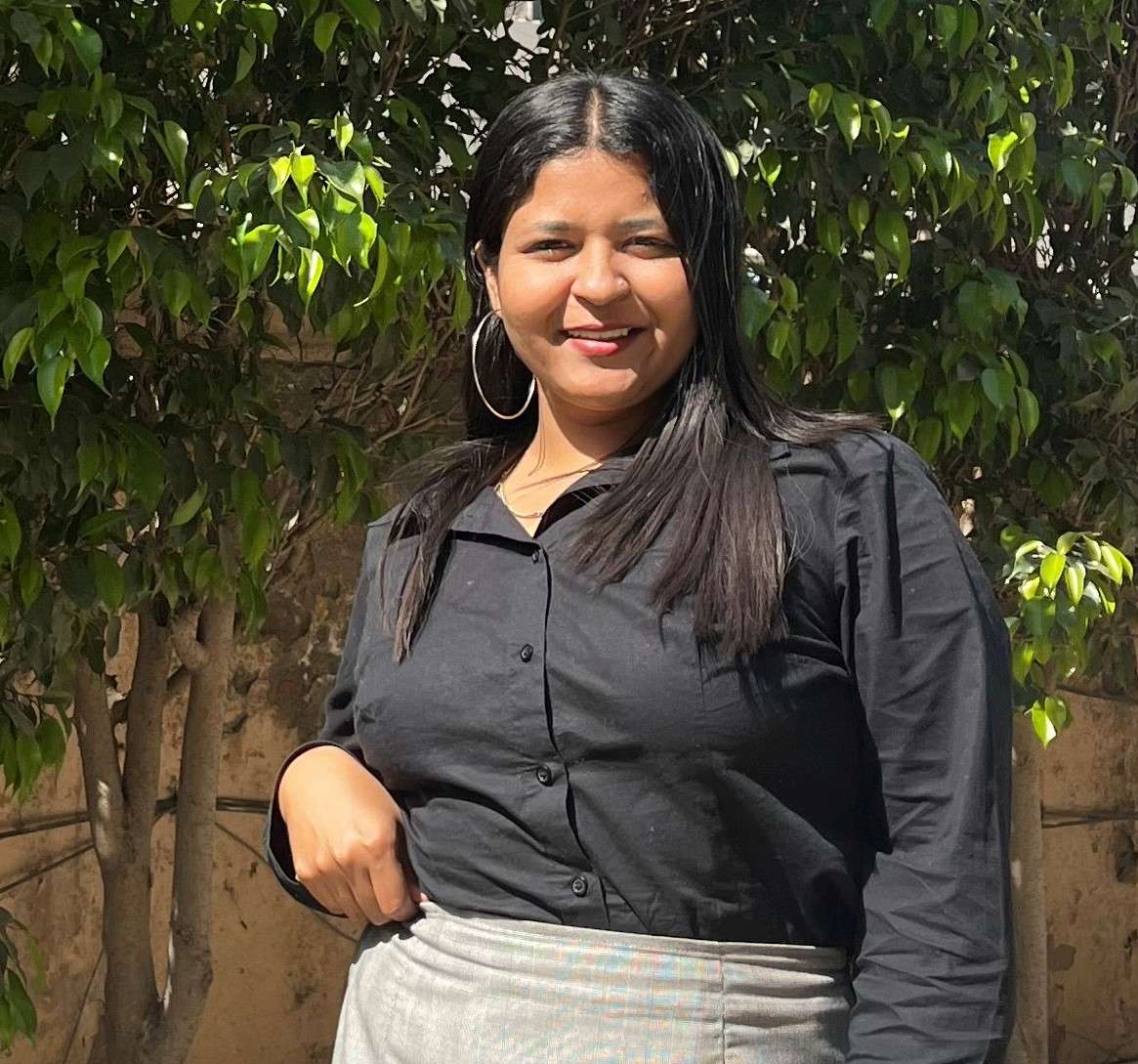
Embrace the essence of surreal places around the world through perfect narratives with a touch of imagination. As a content writer, I weave my ideas and words together to create a vivid picture of alluring destinations. Embark on limitless adventures as you read thrilling travel stories.











